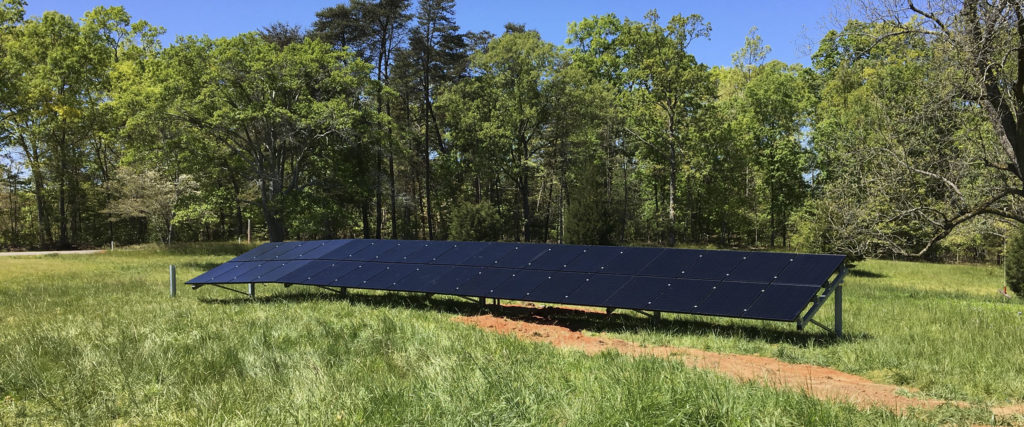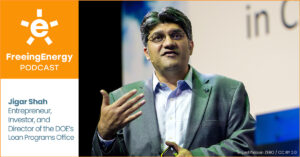(Reading time: 4 minutes)

Ask most experts and they’ll tell you that local energy systems like microgrids and community solar can be expensive and tough to build. If this is true, can local energy really be a faster path to cleaner energy?
As with most things, the real answer is never simple. Local energy champions, like Don Harrod of Minster, Ohio and Eric Coffman of Montgomery County, Maryland, are already proving that locally generated, highly resilient power systems are not only feasible, they can be cost-competitive with traditional grid power. But will their successes translate to everyone else?
Building my own microgrid
Inspired by small-scale Local Energy pioneers like Henk Rogers and Mac McQuown, I decided the best way to understand the challenges of local energy was to build my own microgrid. So, in late 2016, I began the planning process to take my North Georgia house entirely off-grid.

The last year and a half hasn’t seen as much progress as I’d like but it’s been incredibly educational. As I wrestled with finding experts, waiting on products and getting multiple project partners to work together, I had an epiphany: I had seen all this before.
Earlier in my career, I was involved with hundreds of projects that were complex, cutting-edge, and drawn out. I realized that building my microgrid had some surprising parallels with building Fortune 500 websites back in the early internet days.
GET MONTHLY NEWS & ANALYSIS
Unsubscribe anytime. We will never sell your email or spam you.
In the early internet, building websites was expensive and slow – similar to many local energy projects today

Let me explain. Back in the late ‘90s, I ran a 3,000 person internet services firm that helped bring companies like GE, Virgin and Home Depot into the internet age. Believe it or not, in 1998, the going price for a sophisticated website started at a million dollars and would take months to complete. It’s hard to believe how much these pioneering sites cost to build, particularly when compared to modern tools like WordPress, Wix, and Squarespace – all of which create better sites, often in minutes, and cost almost nothing.
How did the cost of building a website drop so dramatically over the last decade?
The answer is simple: volume.
Volume may be one of the greatest inventions of modern business. Henry Ford’s high volume manufacturing of his Model T changed automobile history. An iPhone would cost millions of dollars if Apple designed each one uniquely for each customer.
Twenty years ago, every website was built from scratch. Technologies from a myriad of small, underfunded vendors had to be woven together, often for the first time. Customers demanded customized solutions so software code was rarely reused. Budgets were hard to come by because the value of websites was still not fully understood. Few people had real expertise so projects were regularly on hold until a specific expert became available.
Compare the challenges from these pioneering site builders with today’s local energy projects – they are surprisingly similar.

Fortunately, as the number of serious websites grew from the hundreds into the tens of thousands, the entire website building process was revolutionized. Best practices, templates, and repeatable processes emerged. Budgets became easy because the ROI was widely understood. People with expertise were no longer scarce commodities. Entrepreneurs came up with new companies to streamline the most common parts of website building. Amazing platforms like Redhat, Apache and the Netscape browser became mainstream – in fact, they were so widely used, they became essentially free.
If websites became so much easier, will Local Energy become easier, too?
Absolutely.
Whether it’s websites, Local Energy or virtually any other new technology, there is a nearly universal path from pioneering idea to mainstream solution:
[table id=2 /]
As more and more Local Energy solutions get built, they will follow the same path that websites did 20 years ago: costs will go down, timelines will shrink and projects will become much simpler. This path to becoming mainstream is further accelerated by the plummeting costs of components like solar panels and batteries.
What does this mean for my microgrid?

The biggest delay in deploying my microgrid has been the Tesla PowerWall 2 batteries. I ordered them in November 2016 and I still don’t have them. (To feel better about it, I tell myself that my batteries are probably doing a lot more good for the world down in Australia or Puerto Rico.)
This is a great example of a self-imposed problem. I didn’t have to choose the most cutting-edge product and I could have canceled the order to purchase from another vendor at any time. But, for me, the delay is frustrating but worth it. I have no doubt that people ordering Tesla’s batteries in 2019 will be getting them in days, not years, particularly as Tesla’s Gigafactory is fully up to speed.
Getting to Local Energy faster
Many experts will say that Local Energy is expensive and tough. While that may be true in some situations today, technology history shows us that it won’t be that way for long. Similar to websites in the ’90s, we are in the early days of building Local Energy. And, like those early internet days, as we build more and more Local Energy, the costs will drop dramatically and permanently.
There’s never been a better time to be a Local Energy pioneer. Purchase community solar, press your local government to build microgrids for emergency services, or build your own microgrid with batteries in your house. Who knows, maybe your efforts will help create the next Google or Facebook of the Local Energy era.



